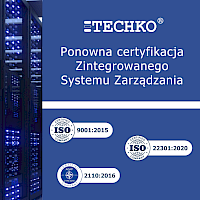
Data Centers of the Future – New Formal-Legal Conditions 1/3
Sustainable development, IT ecosystems, and green IT are just a few of the terms that have emerged in recent years in the field of data centers. These terms influence the way data centers are designed, constructed, and operated. Concern for the natural environment of our planet, the limitation of the negative impact of the technical infrastructure of designed and operated centers, is gaining importance year by year. From desired and expected actions, we are now moving to a stage where these actions are formalized.
The first formal requirement that has appeared in this area and applies within the European Union is ESG reporting (Environmental, Social Responsibility Corporate Governance). Under this requirement, companies report a complete set of criteria assessing the company's activities in terms of its impact on the environment, relationships with employees, suppliers, customers, and the quality of management.
The second formal requirement is a legal act directly related to the designed and operated data centers, namely the Directive of the European Parliament and of the Council of the EU 2023/1791 of September 13, 2023, on energy efficiency. Article 12 of this regulation directly refers to data centers. Until May 15, 2024, and then annually, EU countries require owners and operators of each center (with an installed IT infrastructure energy demand of at least 500 kW) to report and disclose information specified in Annex VII of the Directive to the public, including: the name, location, and area of data center rooms, installed power, annual data flow, amount of stored and processed data. The results achieved by the centers will also be monitored according to key indicators related to energy consumption, power usage, set temperature values, utilization of waste heat, water consumption, and the use of energy from renewable sources.
The above-mentioned formal-legal requirements will have a significant impact on the way data centers are designed and subsequently operated. Incorporating these requirements into the design process and applying new technological solutions (which will be described in the next segment) that meet the demands of new information technologies will be the basis for the commercial success of these projects.
To be continued...



